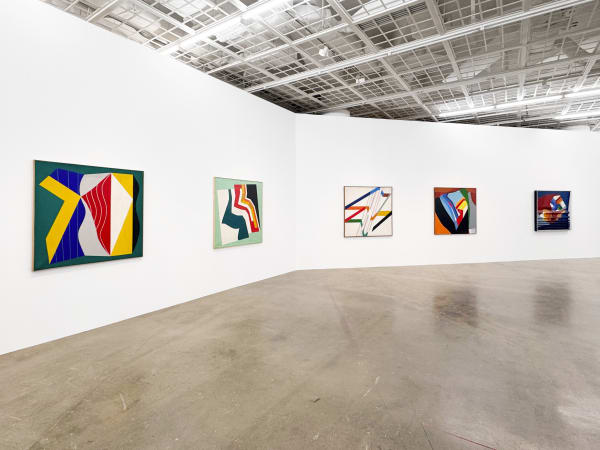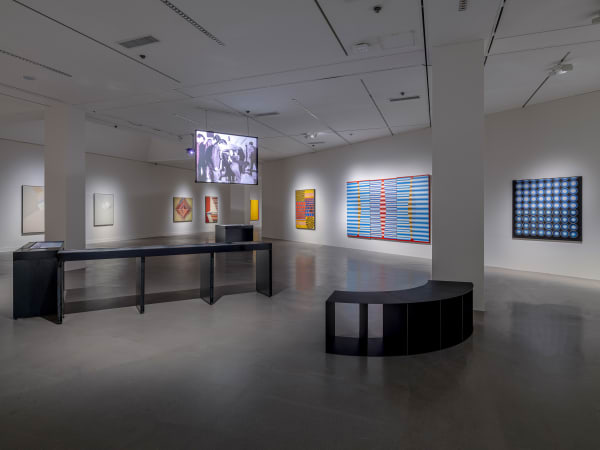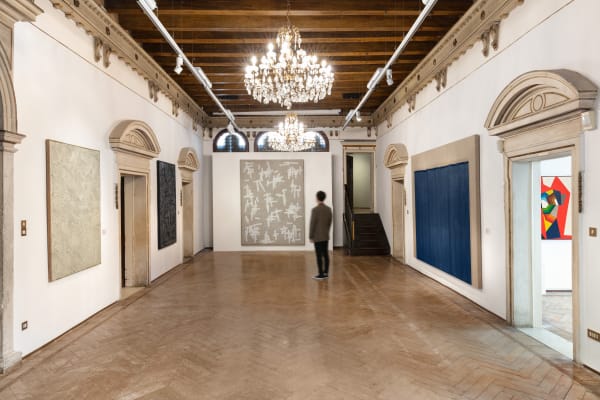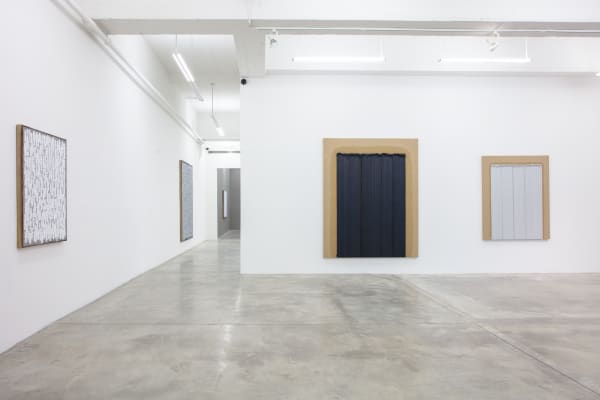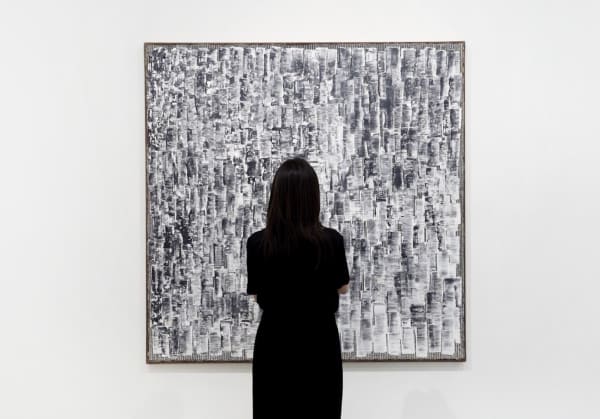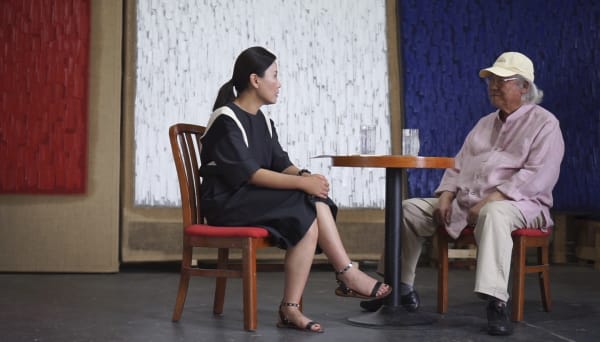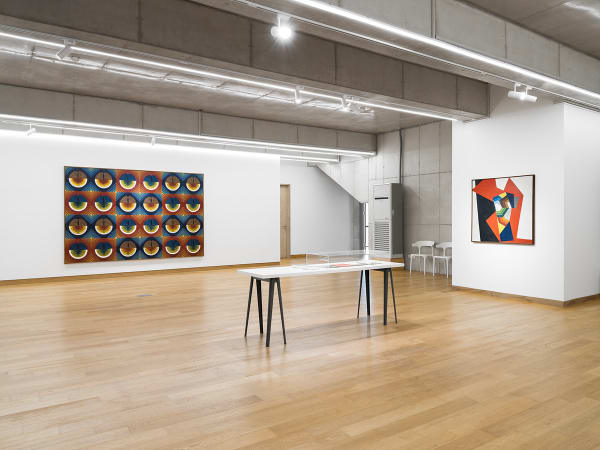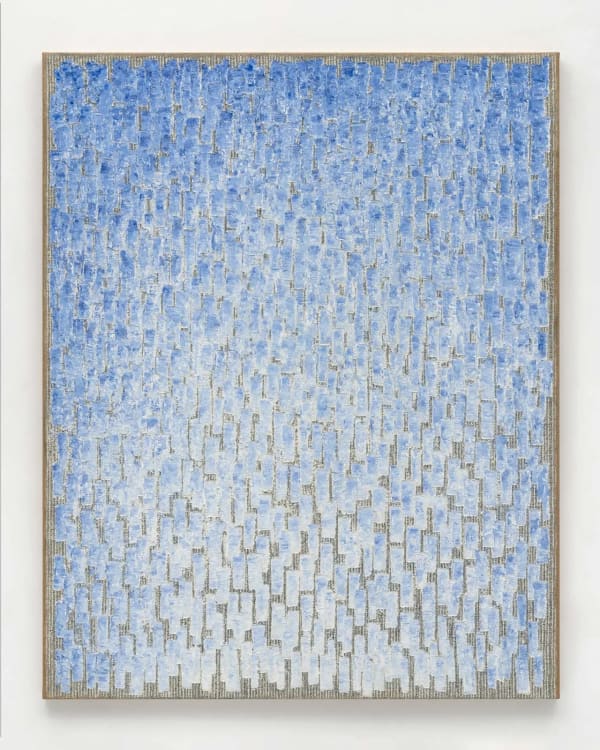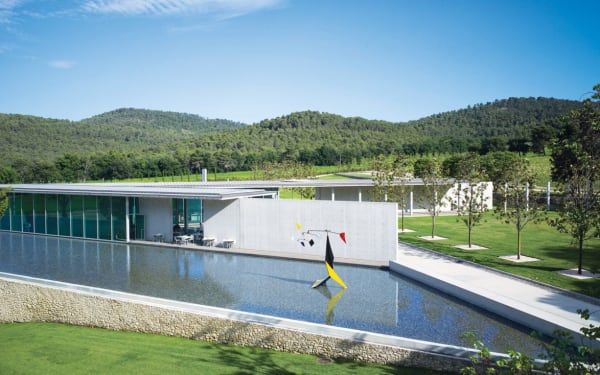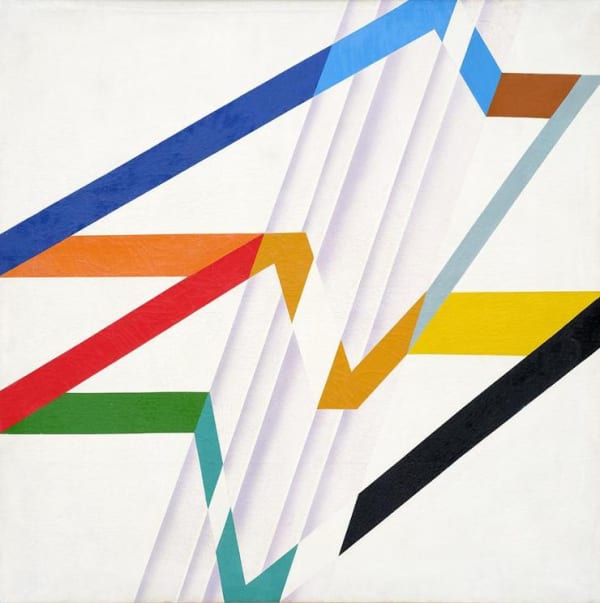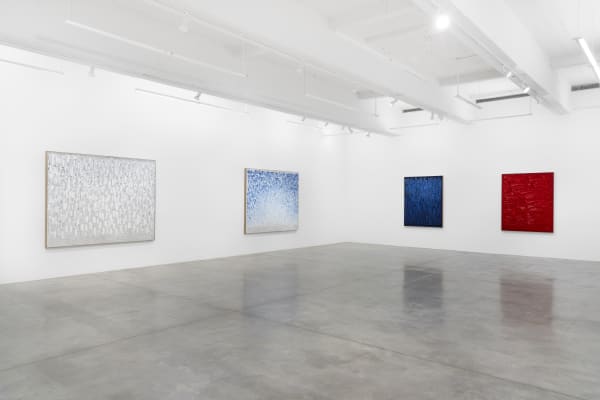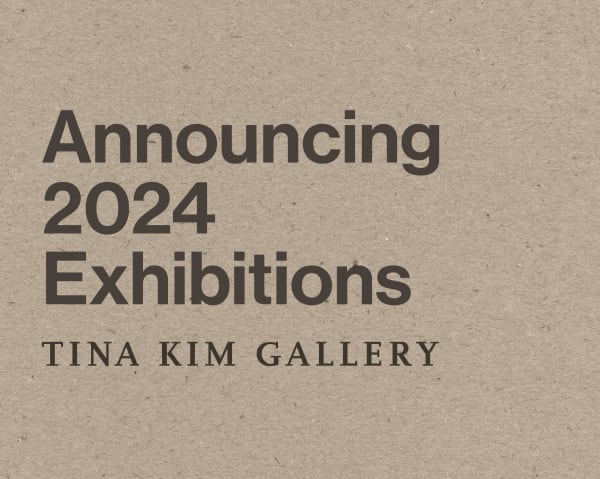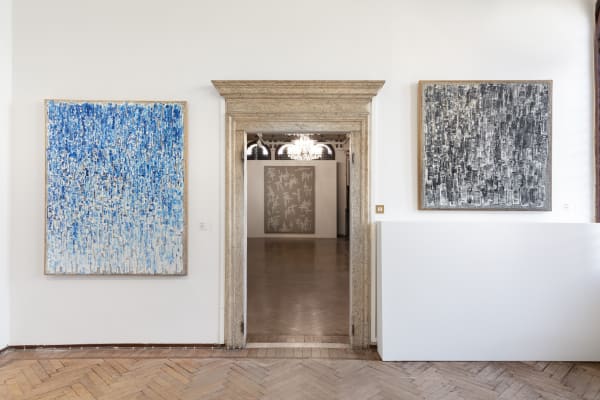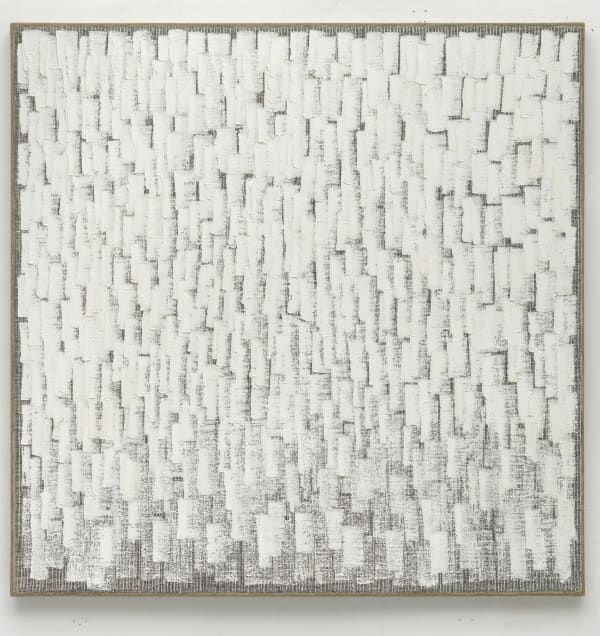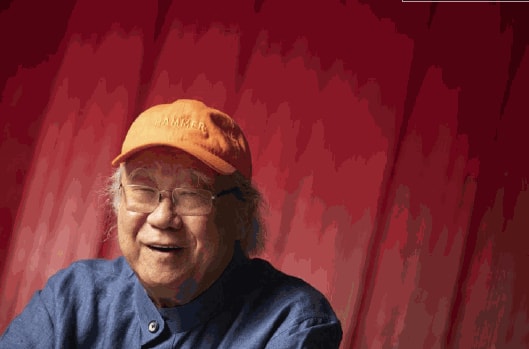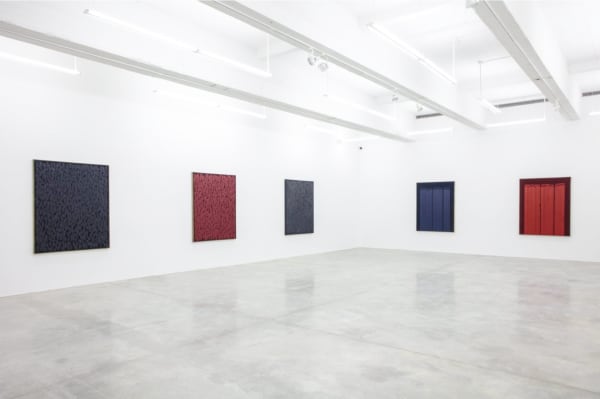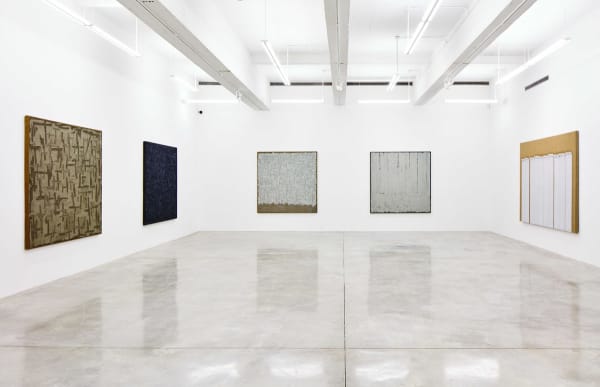Ha Chong-Hyun (b. 1935) is a prominent figure in the Dansaekhwa movement, which is often characterized by Korean monochrome painting. This movement distinguishes itself from Western abstract minimalism through its research of the formal structure of the picture plane and incorporation of East Asian spirituality.
Pivotal within Dansaekhwa, Ha has been associated with various artistic styles throughout his career, from Art Informel in the 1950s and geometric abstraction in the late ’60s, to experimental object-based works in the early ’70s. Ha is perhaps best-known for his “Conjunction” series, which he started in the mid-1970s and continues today alongside his “Post-Conjunction” series. Throughout his work, Ha has consistently explored the properties and possibilities of materials, while in dialogue with the broader concerns and discourses of the Korean art scene of his time.
In 1969, Ha co-founded the Korean Avant-Garde Association (AG), which included artists and critics in their thirties who sought to generate a new formative direction for Korean art under the banner of avant-garde. The association published a periodical and held group exhibitions. During this time, Ha challenged conventional views on mediums, and fostered dynamic interactions between different materials by incorporating objects like barbed wire and springs into his works.
Ha’s experimentation with materials continued even after his return to canvas in the mid-1970s. In 1974, he began his “Conjunction” series, in which he pushes thick oil paint from the reverse side of a plain, woven-hemp canvas. Unlike other contemporary works that emphasize flatness, Ha’s paintings, as noted by art critic Nakahara Yusuke, expand space outwards in a direction perpendicular to the canvas.[1] At the same time, the artist harmoniously unites paint with burlap by allowing the paint to penetrate through the coarse weave of the burlap. Thus, the “Conjunction” series can be understood less as traditional painting and more as an extension of his object-based practice’s strong emphasis on materiality. As critic Lee Yil pointed out, Ha’s canvas works should be viewed as “flattened objects.”[2] During the mid- to late 1970s, Ha primarily worked with paint and the natural color of hemp cloth, seeking a “conjunction” between the two. Ha transformed the paint into a material that is physically integrated with the burlap itself.
By the mid- to late 1980s, his practice transformed to foreground the physical body, revealing how the materiality of his work is engaged through the artist’s actions. In the 1990s, while his bold brushstrokes continued to highlight the physical act of painting, Ha began experimenting with a darker, more saturated color palette. His “Post-Conjunction” series, started in 2008, reinterprets and expands upon the technique he used in the “Conjunction” series by incorporating oil paint squeezed between canvas-wrapped wooden sticks and repeatedly scratching the paint with a tool he crafted himself. His focus on materiality, form, and process reveals a deep commitment to examining the intersections between physical and conceptual aspects of art. This ongoing exploration not only solidifies his place within the Dansaekhwa movement, but also positions him as a significant contributor to the dialogue surrounding contemporary painting in a global context.
Ha Chong-Hyun has lived and worked in Seoul since graduating from Hongik University in 1959. Awarded an honorary doctorate degree from the institution, he served as the Dean of the Fine Arts College at Hongik University from 1990 to 1994. From 2003 to 2006, Ha was the Director of the Seoul Museum of Art. Ha has exhibited in major solo exhibitions and group presentations at museums and institutions around the world, including the Venice Biennale, Gwangju Biennale, São Paulo Biennale, Busan Biennale, Hammer Museum in Los Angeles, the National Museum of Contemporary Art in Gwacheon, the Denver Art Museum, Song Art Museum in Beijing, the Solomon R. Guggenheim Museum in New York, the Brooklyn Museum in New York, Erarta Museum in St. Petersburg, the Art Institute of Chicago, and Fondazione Mudima in Milan. His works are included in the permanent collection of various renowned institutions, such as the Guggenheim; the Art Institute of Chicago; M+ in Hong Kong; Tokyo Metropolitan Art Museum; the Museum of Contemporary Art in Hiroshima; Leeum, Samsung Museum of Art in Seoul; and the National Museum of Modern and Contemporary Art (MMCA) in Korea.
-

MMCA Collection: Korean Modern and Contemporary Art II
MMCA Gwacheon 26 Jun 2025 - 27 Jun 2027The permanent exhibition MMCA Collection: Korean Modern and Contemporary Art II at MMCA Gwacheon presents over 120 significant works from the museum’s collection, produced during the latter half of the...Learn More -

Ha Chong-Hyun: Light Into Color
Château La Coste | Renzo Piano Pavilion 22 Jun - 1 Sep 2025We are delighted to announce a major solo exhibition by Ha Chong-Hyun, one of Korea’s most celebrated artists and a leading figure of Dansaekhwa, the monochrome painting movement that emerged...Learn More -

MMCA Collection: Korean Contemporary Art
MMCA Seoul 1 May 2025 - 3 Mar 2027This exhibition is the first permanent exhibition since the opening of the Seoul branch of the National Museum of Modern and Contemporary Art, Korea (MMCA) in 2013. Since beginning its...Learn More -

Ha Chong-Hyun 5975
Art Sonje Center 14 Feb - 20 Apr 2025Art Sonje Center is pleased to present Ha Chong-Hyun 5975 , an exhibition dedicated to the early works of Ha Chong-Hyun, spanning the years 1959 to 1975. Running from February...Learn More -

Ha Chong-Hyun
50 Years of Conjunction 7 Nov - 21 Dec 2024Learn More -

Geometric Abstraction in Korean Art
MMCA Gwacheon 16 Nov 2023 - 19 May 2024Geometric Abstract art is a style of painting that emphasizes geometric shapes, primary colors, and a flat picture plane. In the West, it emerged through works by Piet Mondrian, Wassily...Learn More -

Ha Chong-Hyun
The 59th Venice Biennale Collateral Event 23 Apr - 24 Aug 2022Collateral Event of the 59th International Art Exhibition – La Biennale di Venezia Curated by Sunjung Kim April 23 – August 24, 2022 | Palazzetto Tito (Istituzione Fondazione Bevilacqua La...Learn More -

Ha Chong-Hyun
Return to Color 8 May - 30 Jun 2021“An artist should constantly grapple with color. And I thought I would be able to finally complete the puzzle of my art when I fill in the missing color.” —Ha...Learn More -

Art Without Borders
30 Nov 2020 - 30 Jan 2021Learn More -

The Winner of 17th LEE Donghoon Art Award : Ha Chong Hyun
The Daejeon Museum of Art 29 Sep - 20 Dec 2020The Daejeon Museum of Art presents the work of Ha Chong Hyun, winner of the 17th Lee Donghoon Award. The Lee Donghoon Award was established to commemorate the artistic legacy...Learn More -

War Within, War Without, Collection 1940s-1970s
Museum of Modern Art, New York, NY 16 Jun 2020Ha Chong-Hyun's Conjunction 74-26 , 1974 is on view in MoMA's Gallery 420: War Within, War Without , a part of its show, Collections 1940s-1970s . Ha Chong-Hyun’s experimental Conjunction...Learn More -

Tina Kim Gallery Presents: Art Without Borders
4 May - 30 Jun 2020Learn More -

Korean Abstract Art: Kim Whanki and Dansaekhwa
Powerlong Museum, Shanghai 8 Nov 2018 - 2 Mar 2019Curator: Wang Chunjie Participating artists: Kim Whanki, Kwon Young-Woo, Chung Chang-Sup, Park Seo-Bo, Chung Sang-Hwa, Ha Chong-Hyun, Lee Ufan 'Shanghai’s Powerlong Museum is pleased to announce Korean Abstract Art: Kim...Learn More -

Ha Chong-Hyun
Conjunction 4 May - 16 Jun 2018Learn More -

Rhythm in Monochrome | Korean Abstract Painting
Tokyo Opera City Art Gallery 14 Oct - 24 Dec 2017Rhythm in Monochrome: Korean Abstract Painting at the Tokyo Opera City Art Gallery. This exhibition features Kim Whanki, Kwon Young-Woo, Chung Chang-Sup, Park Seo-Bo, Chung Sang-Hwa, Ha Chong-Hyun, and Lee...Learn More -

When Process Becomes Form: Dansaekhwa and Korean Abstraction
The Boghossian Foundation 20 Feb - 24 Apr 2016Kukje Gallery / Tina Kim Gallery and The Boghossian Foundation – Villa Empain present: When Process Becomes Form: Dansaekhwa and Korean Abstraction Chung Chang-Sup, Chung Sang-Hwa, Ha Chong-Hyun, Kim Whanki,...Learn More -

Ha Chong-Hyun
Conjunction 6 Nov - 12 Dec 2015Learn More -

Ha Chong-Hyun
Kukje Gallery 17 Sep - 25 Oct 2015Kukje Gallery is pleased to present a solo exhibition of Ha Chong-Hyun, one of the leading members of Dansaekhwa. This exhibition provides a valuable opportunity to experience an important artist...Learn More -

Dansaekhwa In Venice
Collateral Event of the 56th International Art Exhibition 15 May - 18 Aug 2015Learn More -

Ha Chong-Hyun Retrospective
National Museum of Contemporary Art (NMOCA), Gwacheon, Korea 15 Jun - 12 Aug 2012The National Museum of Contemporary Art, Korea (NMOCA) presents the exhibition Ha, Chong-Hyun Retrospective from 15th June - 12th August, 2012. To help establish a comprehensive history of contemporary art...Learn More
-

Ha Chong-Hyun Art Center Opens in Paju, Honors Lifework of 'Dansaekhwa" Master
The Korea Times August 31, 2025At 89, artist Ha Chong-hyun arrived Friday at a new art center named after him, seated in a wheelchair pushed by his daughter. With frail...Learn More -

In Light Into Color, Artist Ha Chong-Hyun Explores Memory and Time
Vogue Philippines July 29, 2025Celebrated Korean artist Ha Chong-Hyun presents his latest major exhibition, Light Into Color , at Château La Coste in Provence. The series of paintings, all...Learn More -

Find Out Where Art World Luminaries Are Traveling This Summer
Galerie May 30, 2025Provence, France | Tina Kim “As soon as Art Basel winds down, I’m hopping on a train to Provence for the opening weekend of Ha...Learn More -

Planning Your Summer Getaway? These Are the 12 Art Experiences Worth Traveling for This Season
Cultured May 26, 2025“Light Into Color” by Ha Chong-Hyun Where: Château La Coste, Le Puy-Sainte-Réparade, France When: June 22–September 1 Why It’s Worth a Look : A pivotal...Learn More -

Lecture on the Early Works of Ha Chong-Hyun
Art Sonje Center, Seoul March 11, 2025Art Sonje Center will host a lecture program on Saturday, March 22 in conjunction with Ha Chong-Hyun 5975 , an exhibition dedicated to the early...Learn More -

Billy Cotton's Top Picks from Frieze Viewing Room
Frieze February 13, 2025The designer’s choices from Frieze Viewing Room includes works by Carolina Caycedo, Alice Neel and Emmanuel Louisnord Desir. Ha Chong-Hyun, Conjunction 24-12 , 2024 Oil...Learn More -

Acts of Nullification in Park Seo-Bo and Ha Chong-Hyun
Art Asia Pacific January 20, 2025If the Korean monochrome movement known as Dansaekhwa has been typically understood as exemplifying notions of emptiness and non-action, then one has to marvel at...Learn More -

Jeong Seon, Rodin, Louise Bourgeois, Mark Bradford: Art to see in 2025
The Korea Times January 1, 2025The Korean art market faced headwinds in 2024, with a prolonged downturn that dampened auction and fair sales after the pandemic-fueled spending spree. August will...Learn More -

50 years into art, Ha Chong-Hyun reinvents with luxury
Jing Daily January 1, 2025In his 50-plus years of being an artist, Ha Chong-Hyun’s debut brand collaboration came with Dior in 2023 — a stark contrast to today’s artists...Learn More -

Three Essential Korean Painters Have Shows in New York Right Now. Run, Don’t Walk
Artnet December 20, 2024New York galleries are about to shutter for their holiday breaks, but before they do, can I entice you to take a pause from shopping...Learn More -

Frieze L.A. 2024: Highlights From the Fair
Women's Wear Daily March 3, 2024“We’re very excited to be in L.A.,” said art dealer and gallery owner Tina Kim, who’s based in New York. Known for introducing Asian artists...Learn More -

This Spring, the Korean Avant-Garde Lands In Los Angeles
Artnet February 9, 2024'Recently, K-culture seems to be attracting global attention,” observes 81-year-old artist Lee Kun-Yong. “After the Korean War, everyone was trying to make a living—pursuing art...Learn More -

Fog Design + Art Fair Celebrates 10 Years With Swift Sales and Artist-First Programming
Artnet January 19, 2024FOG Design+Art Fair has hit its 10-year milestone—and its stride. The fair opened on January 18 at San Francisco’s waterfront Fort Mason Center to a...Learn More -

Announcing 2024 Exhibitions
January 5, 2024Tina Kim Gallery is proud to announce our 2024 programming. Our spring season begins with a solo exhibition of Amsterdam-based artist Jennifer Tee , whose...Learn More -

5 Museum Shows to See This Fall in New York City
Testudio September 5, 2023Only the Young: Experimental Art in Korea, 1960s-1970s , The Guggenheim - Sept 1 - Jan 7 Korean Experimental art (silheom misul ) was born...Learn More -

Frieze Debuts in Seoul, With Big-Name Galleries and a Hometown Spectacle
The New York Times August 30, 2022High-end art fairs have been giving themselves global brand extensions for years, and the latest one, Frieze Seoul, is among the more ambitious. Frieze —...Learn More -

Ha Chong-Hyun, retrospective
Juliet July 28, 2022Collateral event of La Biennale di Venezia April 23—August 24, 2022 By Marina Zorz The Fondazione Bevilacqua La Masa is hosting one of the collateral...Learn More -

Ha Chong-Hyun
The New York Times April 21, 2022VENICE — After a delay, this city is once again filled with the art class — the pavilions are full, and the parties are thrumming....Learn More -

Ha Chong-Hyun
E-flux March 28, 2022Collateral Event of the 59th Venice Biennale April 23–August 24, 2022 Kukje Art and Culture Foundation is pleased to present a solo exhibition of work...Learn More -

Best Gallery Exhibitions Summer 2021
Observer June 1, 2021This summer galleries are opening doors and welcoming in art lovers, we picked out the ones you won't want to miss. “Return To Color” with...Learn More -

What Abstraction Can Face Up To
Hyperallergic May 15, 2021Ha Chong-Hyun has survived the many catastrophes that have befallen Korea during his lifetime, and his work is inextricable from his life.Learn More -

'Dansaekhwa' artist Ha Chong-hyun holds exhibition in New York
The Korea Times March 12, 2021'Dansaekhwa' artist Ha Chong-hyun, 86, is exhibiting his latest works showcasing his 'relationship with color' at Tina Kim Gallery in New York through June 30....Learn More -

Dansaekhwa artist Ha Chong-hyun presents 'Conjunction' in London
The Korea Times October 7, 2020Renowned dansaekhwa (Korean monochrome painting) artist Ha Chong-hyun opened a solo exhibition at Almine Rech Gallery London, Tuesday. The artist, 85, is best known for...Learn More -

A Full View, at Last, of Modern Art in South Korea
The New York Times June 25, 2020Many rich nations use art, music and movies to project an image to the world, but few take it as seriously as South Korea —...Learn More -

8 Fascinating Finds from the FOG Design+Art Fair in San Francisco
Galerie Magazine January 15, 2020The booming tech industry has yielded a crop of new collectors who favor younger new-media artists, as well as those bridging utilitarian design with sculptural...Learn More -

Tina Kim Gallery Presents Dansaekhwa Works at FOG
Whitewall Magazine January 15, 2020FOG Design + Art opens tomorrow in San Francisco. Of the 48 galleries participating, there are several first-timers, including Tina Kim Gallery. Whitewaller caught up...Learn More -

The 10 Best Booths at Art Basel in Miami Beach
Artsy December 5, 2019For her first-ever solo presentation at Art Basel in Miami Beach, Tina Kim selected a handful of Dansekhwa (Korean minimalist) works in addition to stranger,...Learn More -

MoMA’s Nimble New Incarnation Is Well Suited to a World in Constant Flux
Artnet News October 17, 2019[...] If you’ve read anything about the reinstallation of MoMA’s collection, you will know the basics: film, photography, design, and architecture holdings have been integrated...Learn More -

Ha Chong-Hyun Finds Conjunction Between Spirit and Performance
The Korea Times June 16, 2019By Kwon Mee-yoo Throughout his career, artist Ha Chong-hyun, 84, has been searching for an answer to a burning question: What are the fundamental elements...Learn More -

Mexico City’s Major Fair Exposes the Art World’s Renewed Love of Craft
Observer February 8, 2019By Michael Anthony Farley The Subtly Subversive Artists of Korea’s Dansaekhwa For all the utopian connotations that come with evident craft and populist aesthetics—a celebration...Learn More -

Ruggedly Refined Monochrome: Ha Chong-Hyun at Tina Kim
Artcritical June 14, 2018By Robert C. Morgan It is not uncommon among contemporary Korean artists to find the same title used repeatedly for different paintings, often over a...Learn More -

The Anguish of Ha Chong-Hyun’s New Red Paintings in “Conjunction”
Whitewall May 10, 2018By Drew Clayton The Korean art movement, Danasaekhwa, might not be a familiar modernist art term to many, compared to others such as Abstract Expressionism...Learn More -

Amid Renewed Interest in Korean Dansaekhwa Art, Ha Chong-Hyun Continues to Experiment
Artsy November 16, 2015By Jennifer Baum Lagdameo Conjunction, the title that Korean artist Ha Chong-Hyun has given all of his paintings since the early 1970s, is also the...Learn More -

A Conversation with Ha Chong-Hyun by Ines Min
Ocula October 1, 2015by Ines Min Among the now internationally acclaimed Dansaekhwa artists, Ha Chong-Hyun (b. South Korea, 1935) is notable for his undeniable influence on the shifting...Learn More -

Skin & Surface What is Dansaekhwa and what is its legacy today?
Frieze February 20, 2015By Yoon Jin Sup, Joan Kee, Sam Bardaouil, and Till Rellrath '...Tansaekhwa artists regarded themselves as painters, yet their kind of painting had little to...Learn More -

Monochrome Sets You Free
Hyperallergic December 16, 2014By: Robert C. Morgan I discovered the work of Ha Chonghyun in 2000 at an exhibition mounted at the Gwangju City Art Museum, curated by...Learn More








